Russian Espionage and Electromagnetic Fields: The Story of the Theremin
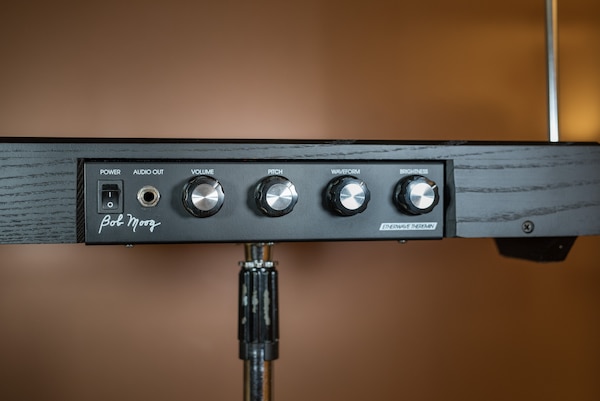
Our series on important music-making devices continues with one of the most forward-thinking instruments of the 20th century
In 1919, 23-year-old Lev Sergeyevich Termen’s new invention began to make a strange noise. Termen’s machine, built at the Physical Technical Institute in St. Petersburg, was originally meant to measure the density of gasses in a chamber. A brilliant and creative young Russian scientist, Termen had wondered what would happen if he added a sonic element to his new device, a whistling noise that indicated the machine’s reading. But he quickly noticed that the sound wasn’t just responding to the density of gasses it was supposed to be measuring – he could change the pitch merely by moving his hands in the air around the device. Waving his hand back and forth, an eerie noise emerged, like a quivering, disembodied voice. As his fellow scientists gathered around this incredible, intangible noisemaker, Termen realized he had a new instrument in front of him. It was a stunning discovery, one that would set Termen, better known as Léon Theremin, on a path that would change the course of 20th century music and entangle him in the politics of the Cold War.
The late 1910s were a revolutionary time for electronics. New technologies were constantly emerging, fueled predominantly by the refinement of the vacuum tube in 1915, which allowed radio and sound amplification to begin in earnest. By directing a current through vacuum tubes, the strength of an electrical signal could be amplified. This set the stage for the invention of speakers, and electronic music. Prior to then, the few electronic instruments that existed took up entire buildings. Now, using vacuum tubes, Theremin was able to make electronic sound with something small enough to put in a phonograph cabinet.
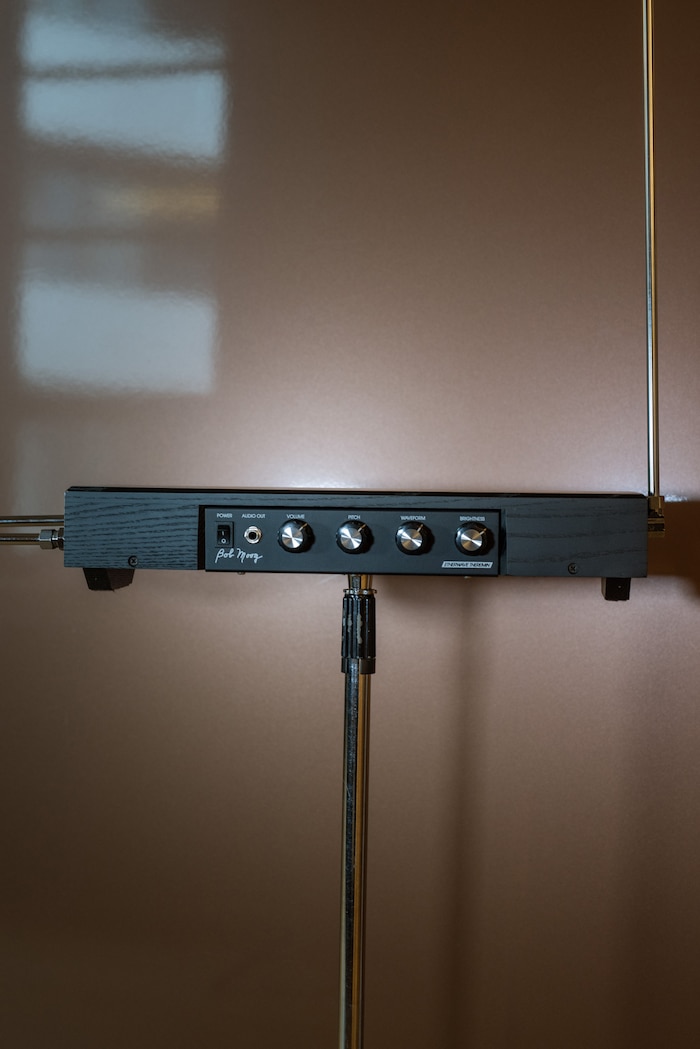
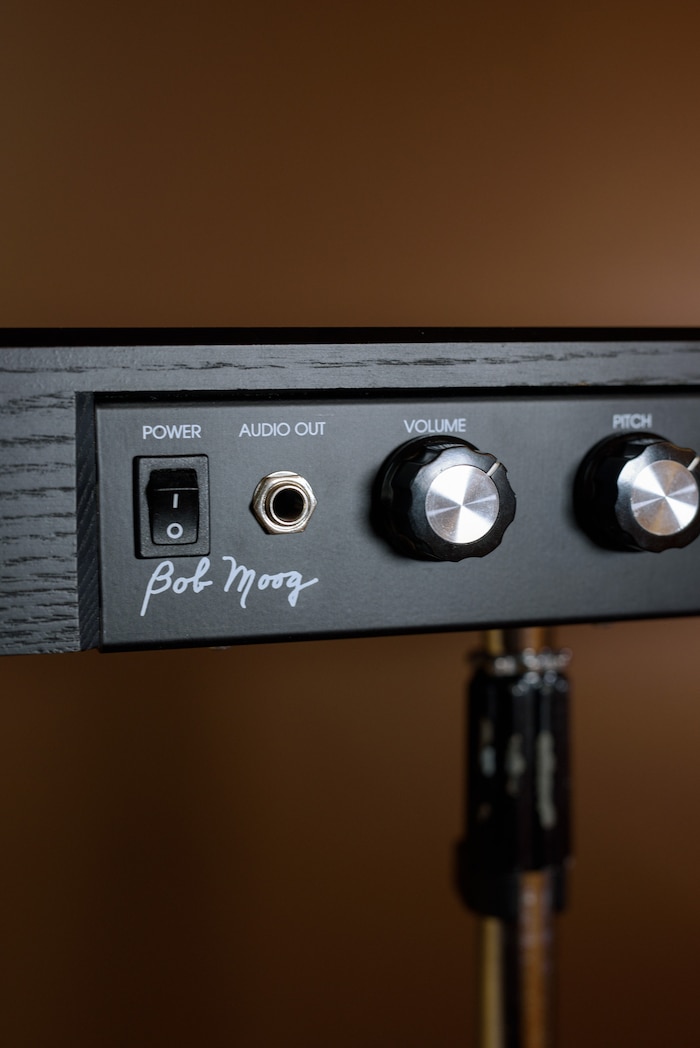
Theremin’s invention was serving a dual purpose – to entertain and to support his nation’s interests – an intertwining of intentions that would continue for almost his entire life
Theremin’s accidental discovery was that the electromagnetic field around an antenna could be affected by merely moving your body into that field. “It’s simply the electromagnetic fields in your own body, what we refer to as capacitance, affecting the circuitry through the electromagnetic field surrounding some device,” says Albert Glinsky, an American composer and the author of Theremin: Ether Music and Espionage. After Theremin’s initial discovery of the sonic potential of his former gas meter, he altered the device into a working instrument. He placed one antenna vertically and one horizontally, meaning that a player could control pitch with their right hand and volume with their left, producing real melodies out of thin air.
As word of Theremin’s new invention spread, he was invited to an audience with Vladimir Lenin, at the time the Chairman of Russia’s new Bolshevik government. Lenin absolutely loved the new instrument. “He was so taken with it,” Glinsky says, “that in 1922 he sent Theremin all around the Soviet Union to demonstrate the instrument as propaganda for electrification.” The idea was that villagers would be so impressed by Theremin’s instrument they’d be motivated to bring the magic of electricity into their homes. Already, Theremin’s invention was serving a dual purpose – to entertain and to support his nation’s interests – an intertwining of intentions that would continue for almost his entire life.
After his successful tour of Russia, in the late 1920s Lenin sent Theremin to Western Europe, where the legend of his mysterious instrument quickly grew. “Theremin gathered huge crowds, because it was such a fascinating thing to see this man stand in front of what looked like a little wood writing desk with two metal antennas, and with nothing but his hands in mid-air, produce these melodies, sounding like a soprano singing,” Glinsky explains. “It was considered magic at the time.”
What audiences didn’t know was that Theremin was already working as a spy for the Soviet regime. While he wowed crowds with his ghostly tunes, played on what was then called the Thereminvox, or “Theremin’s voice,” he kept his eye out for any information that might be useful to report back to his homeland. “This was the great ruse, because everybody was so focused on this magician pulling music out of thin air that he was able to gain access to industrial places and patent offices and all sorts of things,” explains Glinsky.
In 1927, Theremin made his way to New York City, where he patented his instrument and made a deal with RCA for the rights to produce 500 of what they now called simply “the theremin.” “RCA marketed it as the instrument that anyone could play,” says Trevor Pinch, author of the history of synthesizer music Analog Days. “This was a huge mistake.” It turned out that playing the theremin was anything but easy. With no keys or fretboard to hold onto and no visual reference points, it took years of practice to play the instrument with any competency. “It would almost be like if you had a piano where the size of keys changed each time you sat down to play it, so you weren’t sure how far apart your fingers had to be to play a scale,” Glinsky says. Unsurprisingly, RCA’s gamble didn’t pay off. Though they sold most of the instruments they built, the theremin wasn’t anything like the hit they’d hoped it would be.
While living in America, the gap between Theremin’s two lives grew more dramatic. While he cavorted in New York with the likes of Albert Einstein, taught the theremin virtuoso Clara Rockmore and entered into a controversial marriage with the African-American prima ballerina Lavinia Williams, his espionage mission continued. This double life wouldn’t last long. The lead-up to World War II made Theremin increasingly nervous that his activities would be discovered, and in September of 1938 he fled the USA without even informing his wife of his planned departure. Thus began a long period during which Theremin’s whereabouts were totally unknown to people in the West, leading to suspicions that he’d been kidnapped by Soviet agents. Glinsky thinks those theories are ridiculous: “He was simply not kidnapped; it was not that mysterious,” he says. “The FBI had a file on him, he had lots of debts and was running out of steam in many ways.” These problems are what really forced him to flee, but it turned out to be a more permanent disappearance than anyone could have predicted: Theremin wouldn’t return to America until 1991.
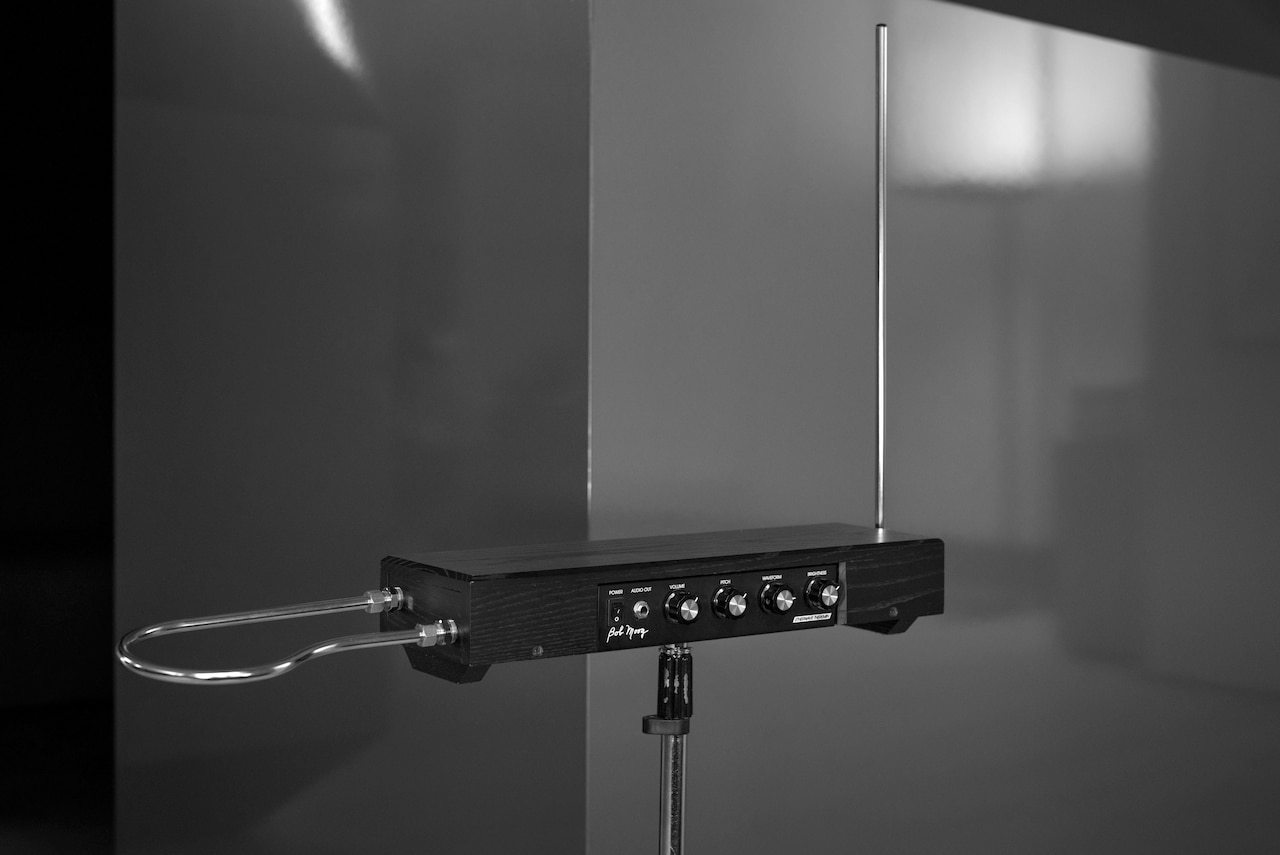
During Theremin’s long absence from the West, his invention’s influence spread. In the 1940s, the public started hearing the theremin’s sounds at the movies. “The theremin was discovered by the Hollywood composer Miklós Rózsa, who wrote the scores for The Lost Weekend and Spellbound,” Glinsky says. Those films, which dealt with the taboo subjects of mental illness and alcoholism, required audio cues to make the audience understand the seriousness of their subjects. “Theremin had intended [the instrument] to replace violins and cellos, to be used as a serious classical music instrument, but it did have this disembodied sound, literally and figuratively,” Glinsky says. “It sounded like some sort of howling outer space noise. So when Rózsa used it to represent the moments of alcoholic stupor for Ray Milland in The Lost Weekend, it was perfect.”
“[The theremin’s sound] came to symbolize psychological distress,” Pinch adds. Later on, this association was used in early sci-fi films like The Day The Earth Stood Still, where the theremin soundtracked the aliens descent from their spaceship. This connection between the theremin and the uncanny influences how the instrument is heard even today: as an otherworldly wail that accompanies the arrival of the unknown.
Soon after the theremin’s silver screen debut, it began to pop up around the birth of music genres like exotica and lounge, where its smooth vibrato was intended to soothe, not scare. “During the ’30s and ’40s, popular band leaders like Les Baxter, who was to become known for exotica music in the ’50s, experimented with the theremin and created sets of music for it,” says Thom Holmes, author of the history Experimental and Electronic Music. In a series of early lounge jazz records by Baxter and Harry Revel called Music For Peace Of Mind, Music Out Of The Moon, and Perfume Set To Music, the theremin, played by the Hollywood thereminist Samuel Hoffman, provided fluttering accompaniment for enchanting orchestral compositions. This was the first time that the sound of the theremin was heard in homes across America.
Though the theremin’s influence continued to grow in the US, it had no effect on the life of its creator, who after his return to the USSR was caught up in Stalin’s purges and sent to a Siberian gulag. Theremin was lucky – unlike the millions who died in these labor camps, he was released after three months, as the Soviet war effort ramped up and the government realized they might actually need some of the scientists they’d banished. So officials rounded up Theremin and others and sent them to a sharashka, a prison where scientists from a variety of fields were forced to invent and research for the Soviet regime. Conditions in the sharashka were considerably more humane than in the gulags, but scientists confined there were kept away from the world at large. Prisoners couldn’t communicate with family, friends or anyone else outside the prison, and if they wanted to marry their only options were others in the sharashka.
It was there that Theremin invented the other device for which he’s remembered. The Great Seal Bug, alternately known as “The Thing,” was an ingenious invention, a passive bug placed inside a wood carving of the Great Seal of the United States and presented to Averell Harriman, the American ambassador to Moscow, by the Soviet equivalent of Boy Scouts. Harriman happily hung the spy device on his wall. The bug was undetectable to the sweepers that were used to find such devices at the time, as it used no electricity. Spies a few houses down from the embassy would point a microwave beam in the direction of the seal, activating a small antenna that picked up noises in a resonant cavity carved out of the seal’s bald eagle’s beak. When turned on, the bug broadcast noises in Harriman’s office for anyone with a radio receiver to hear. The bug remained, unexposed, for seven years, before conversations were picked up accidentally by a British radio operator nearby, who alerted authorities and prompted an investigation.
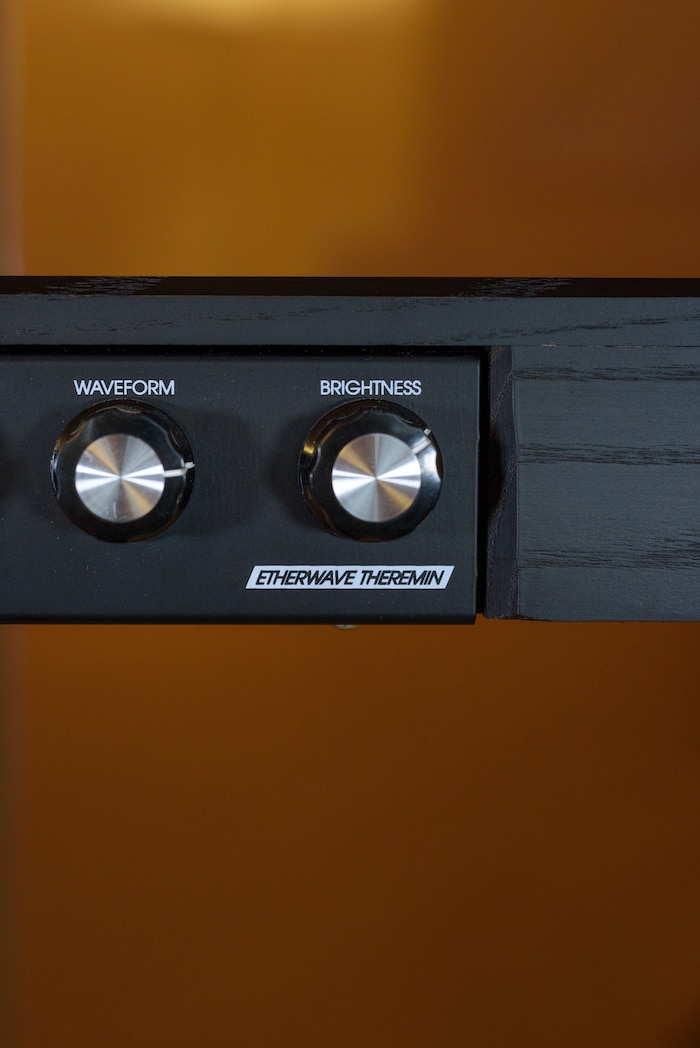
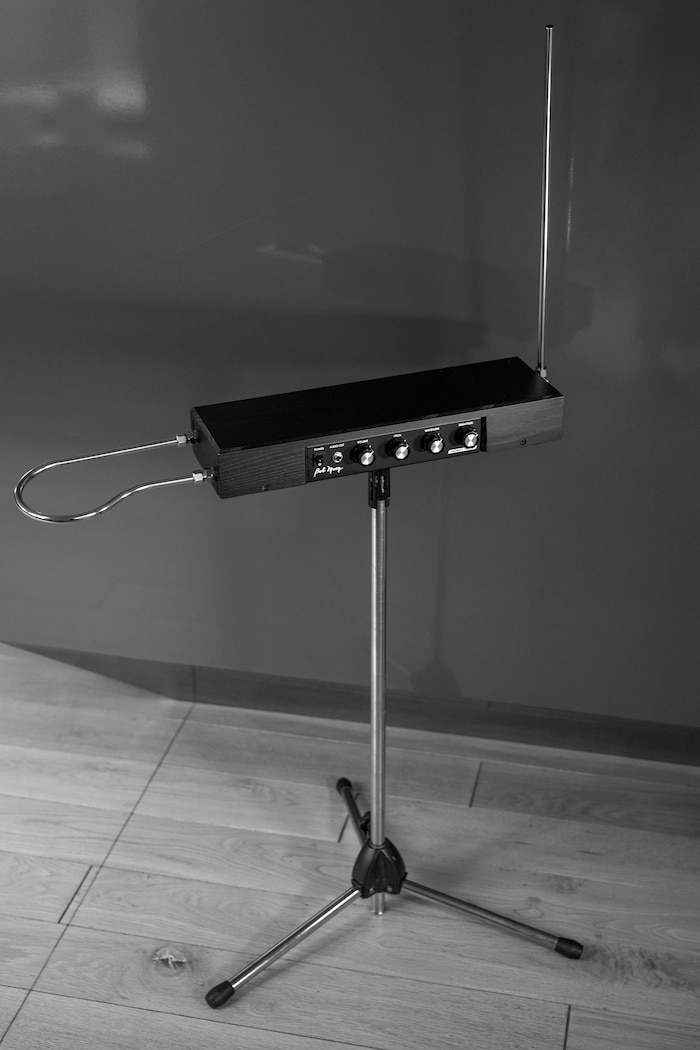
Bob Moog’s first and last love was theremins, and in between he invented the electronic music synthesizer.
While the Great Seal Bug was broadcasting the results of its eavesdropping to Russian authorities, Theremin’s namesake instrument was about to receive another lease on life. At that point, theremins hadn’t been manufactured in the US since the unsuccessful RCA run in the 1920s, but in New York City a teenager by the name of Robert Moog had learned of the instrument and become immediately transfixed. Moog, who would go on to invent the modular synthesizer and revolutionize electronic music, loved building electronics out of kits. He realized that the theremin was something he could build. With this father, he began to create home theremin kits, eventually selling them via mail-order to the small niche of electronics nerds who wanted to build their own. This was how the Moog company got its start: selling theremin kits out of Moog’s childhood home in Queens in 1954.
Theremins remained Moog’s enduring obsession. “His first and last love was theremins, and in between he invented the electronic music synthesizer, is how Bob would often put it,” Pinch says. As it turned out, Theremin’s technology would never be as popular as the synthesizer that that became Moog’s main legacy. “Basically, the interface that became dominant was all these buttons and levers, and the gesture, waving through the air, was totally abandoned,” says Sean Michaels, a music journalist and the author of Us Conductors, a novel based on Léon Theremin’s life.
Despite the theremin’s continued obscurity, its sounds began to seep into everyday life via popular music. The 1967 Rolling Stones’ albums Between The Buttons and Their Satanic Majesties Request both featured Brian Jones on theremin. In 1969, Led Zepplin used theremin for the trippy breakdown in their song “Whole Lotta Love,” probably the most popular song to use a real theremin up to that point. The pop song that’s most often associated with theremin history, The Beach Boys’ “Good Vibrations,” actually doesn’t use a theremin at all – it used a tactile ribbon controller synth that was created specially for the song. But the timbre was much the same as the theremin, and “Good Vibrations” helped introduce electronic sounds to the mainstream. Psychedelic bands also found the theremin fascinating, and made use of its wild sound and appearance. “There was a famous 1960s psychedelic band called Lothar and the Hand People,” Pinch says. “Lothar was the name of their theremin. The Hand People were the musicians, you see, waving their hands near Lothar.” Captain Beefheart also used theremin on “Electricity,” a song off his legendary album Safe As Milk.
While the Theremin slowly infiltrated popular culture, though, its creator had effectively disappeared. “[In the mid-20th century], many people in the US thought that Theremin was dead, that he had somehow died during the Second World War,” Glinsky says. Theremin had been silent since his stealthy escape from New York in 1938. Rumors of his execution were published in Russia. But Theremin was alive and well – after his release from the sharashka in 1947, he continued to work with the KGB until 1966. But his status remained unknown by most until 1967, when the American journalist Harold Schonberg, a critic for the New York Times, found Theremin by accident at the Moscow Conservatory, where he was working. Schonberg wrote a story revealing Theremin’s status and continued work in music to a thrilled Western audience. In Russia, the government wasn’t so amused by Theremin’s comeback.
“[The government] thought, ‘This is really bad. This guy has a history of espionage, he’s a hot property. We cannot afford to have him become a celebrity,’” Glinsky explains. “The reaction to [the article] was that the head of the conservatory came into Theremin’s little lab where he had built all these instruments, and essentially took all of them and threw them out into a dumpster and fired Theremin.”
Although he invented one of history’s most fascinating instruments, Theremin’s genius was severely limited by the somewhat tragic circumstances that shaped his life
This is how much of Theremin’s later life in the USSR played out. Tainted as a former spy and unable to leave the country, he kept a low profile while he tried continue his work. “All of Theremin’s lifelong possessions and inventions, and his materials, were all whittled down to what could fit into one bedroom in a communal apartment at the end of his life,” Glinsky says. Finally, in the early ’90s, after the opening up of the Soviet regime that began the dissolution of communism in Russia, Theremin was finally allowed to leave the country. He traveled to Europe and the US to play music and speak to admirers and documentarians, including Glinsky.
Theremin’s creative spirit never left him. “[In his old age], he was working all sorts of inventions, like 21st century dancefloors where people would be on giant terpsitones [massive theremins played with the whole body], moving their bodies and creating the music through electromagnetic fields,” Glinsky says. “All sorts of things that he conjured up in his mind in his very old age, he wanted to live to invent, but unfortunately he didn’t.” Theremin died in 1993, in Russia, at the age of 97.
Around the time of Theremin’s death, his instrument’s sound became more popular than ever among innovative musicians. But though many bands, from Radiohead to Portishead, used theremin-like sounds, few used the instrument itself. Nine Inch Nails was one of those that did – multi-instrumentalist Charlie Clouser played theremin on the band’s tracks throughout the ’90s. Wayne Coyne of the Flaming Lips also played the theremin on the 1999 single “Race For The Prize,” and in live performance. A 1993 documentary, Theremin: An Electric Odyssey, helped reignite interest in the instrument as well. “It’s a visually compelling instrument, and that’s part of the reason I think it’s had a revival today,” Pinch says. “You can now process the theremin through a synthesizer or use it to trigger sounds. That makes the instrument even more versatile.”
Moog has played a role in the theremin’s revival as well. In 2014, his company released a new instrument, the Theremini, with the goal of giving the instrument a gentler learning curve. “As you move your hand [on the Theremini], it will actually put the notes into scales, recognized chromatic scales, so you can choose your scale and it will do it automatically,” says Pinch. “I like to call the Theremini kind of a theremin with training wheels,” says Glinsky. The Theremini comes with a knob that allows you to change the level of this guidance, so over time, the player can train themselves to know the position of scales on their own, and prepare themselves to play a real theremin.
The theremin has also made a reappearance in contemporary films, including on the scores for Ed Wood and The Machinist, which both featured one of today’s preminent theremin players, Lydia Kavina. Kavina, who was born in Moscow and now lives in the UK, is the granddaughter of Theremin’s first cousin, and the man himself taught her to play the instrument, starting when she was nine years old. “If you look back 20 years ago, there were almost no [theremins] to buy, almost no players to find,” she says. “There was very little information about the instrument in general. Today, we have thousands of theremin instruments and thousands of theremin players of different levels.” She feels it’s her duty to bring awareness of her old teacher’s instrument to as many people as possible. “Every day, I open something new with the theremin,” she says. “It’s such a new instrument that there so many things still to discover.”
Curiously enough, waving your hands in the air to control a device is more common today than at any time in the past. Video game platforms like Wii and technology like Leap Motion, which allows for gestural control, are picking up where Theremin began nearly 100 years ago. Capacitance, the same phenomenon that allows for the theremin to respond to the human body, is what helps your smartphone recognize the drag of your finger across the screen. We are finally beginning to catch up to the reality Theremin dreamed up a century ago.
Although he invented one of history’s most fascinating instruments, Theremin’s genius was severely limited by the somewhat tragic circumstances that shaped his life. Still, the forces that imprisoned him could never constrain his imagination. In a world of seemingly infinite technological wonders, the theremin, now over 100 years old, can still inspire a sense of awe, the spectral voice of a machine calling to us from a faraway time.
Header image © Elizabeth Herring

